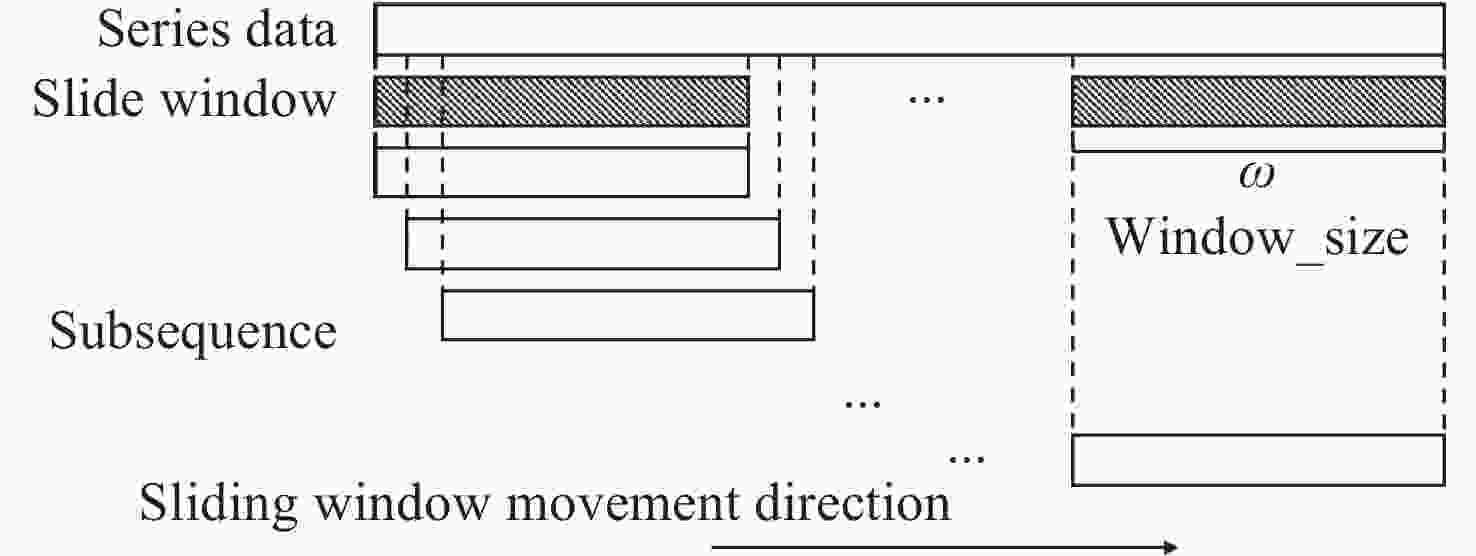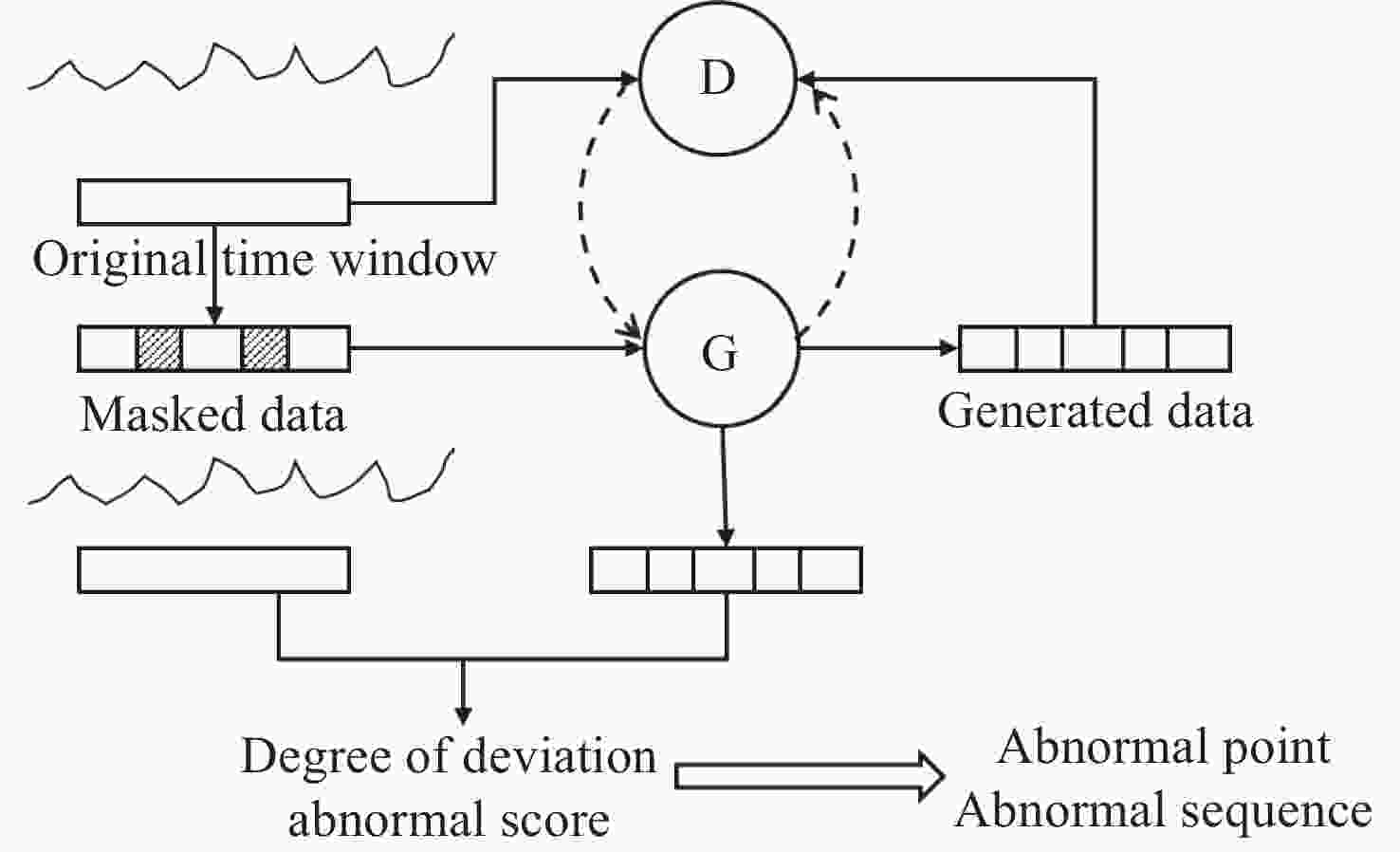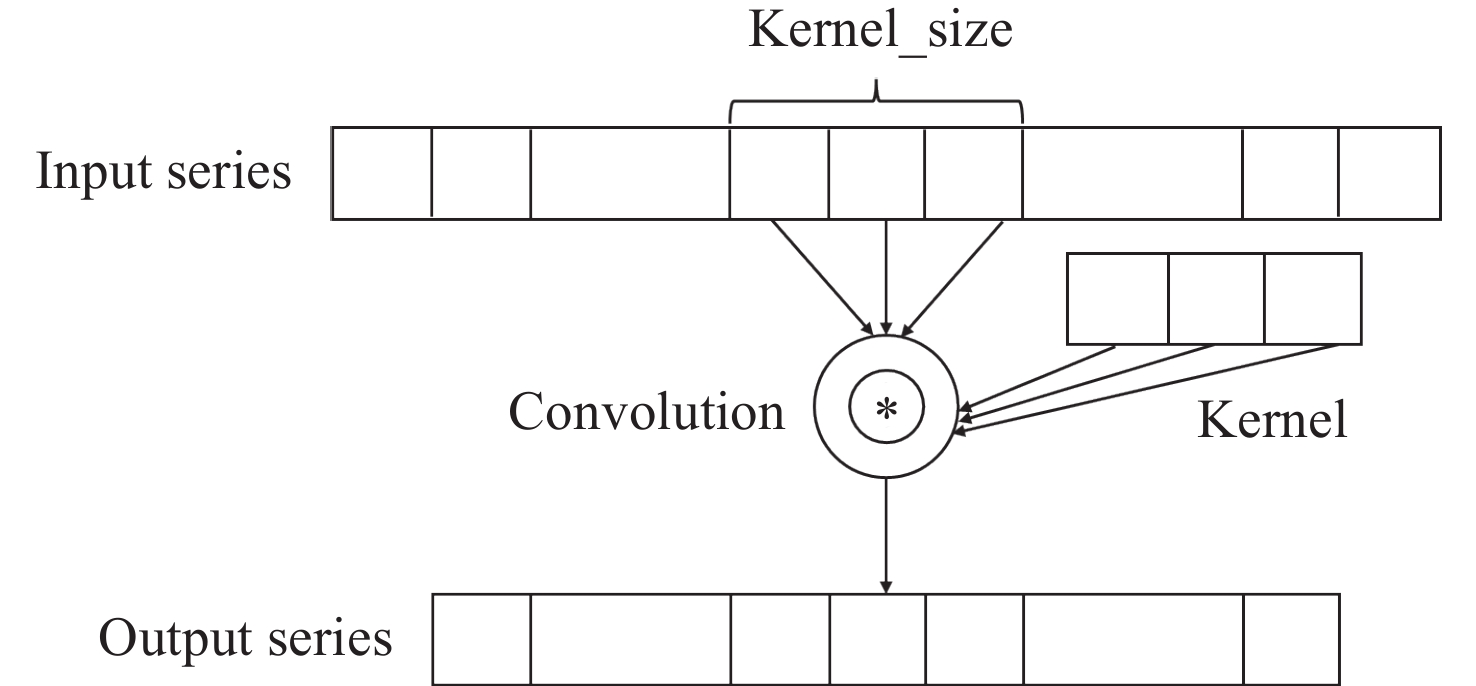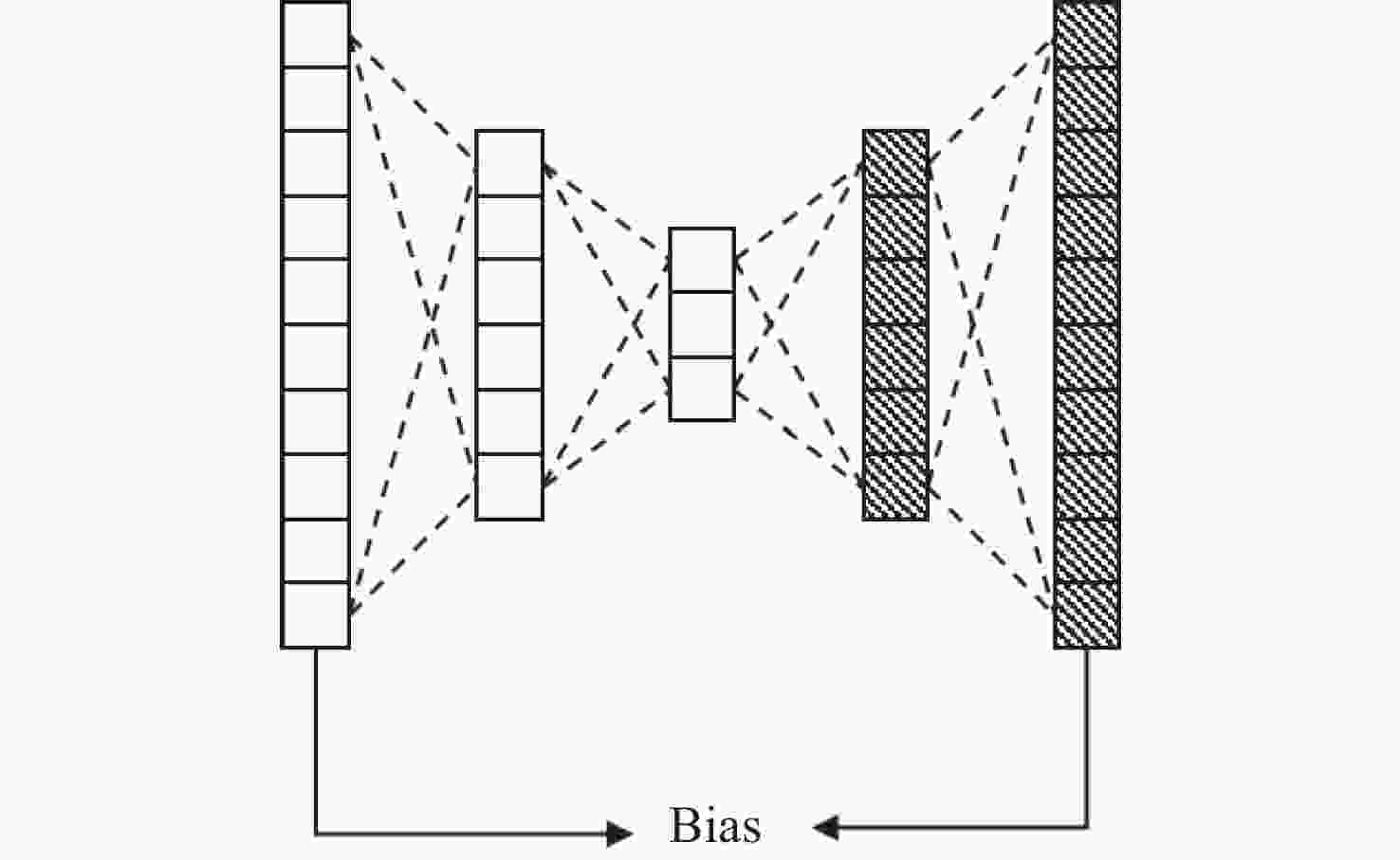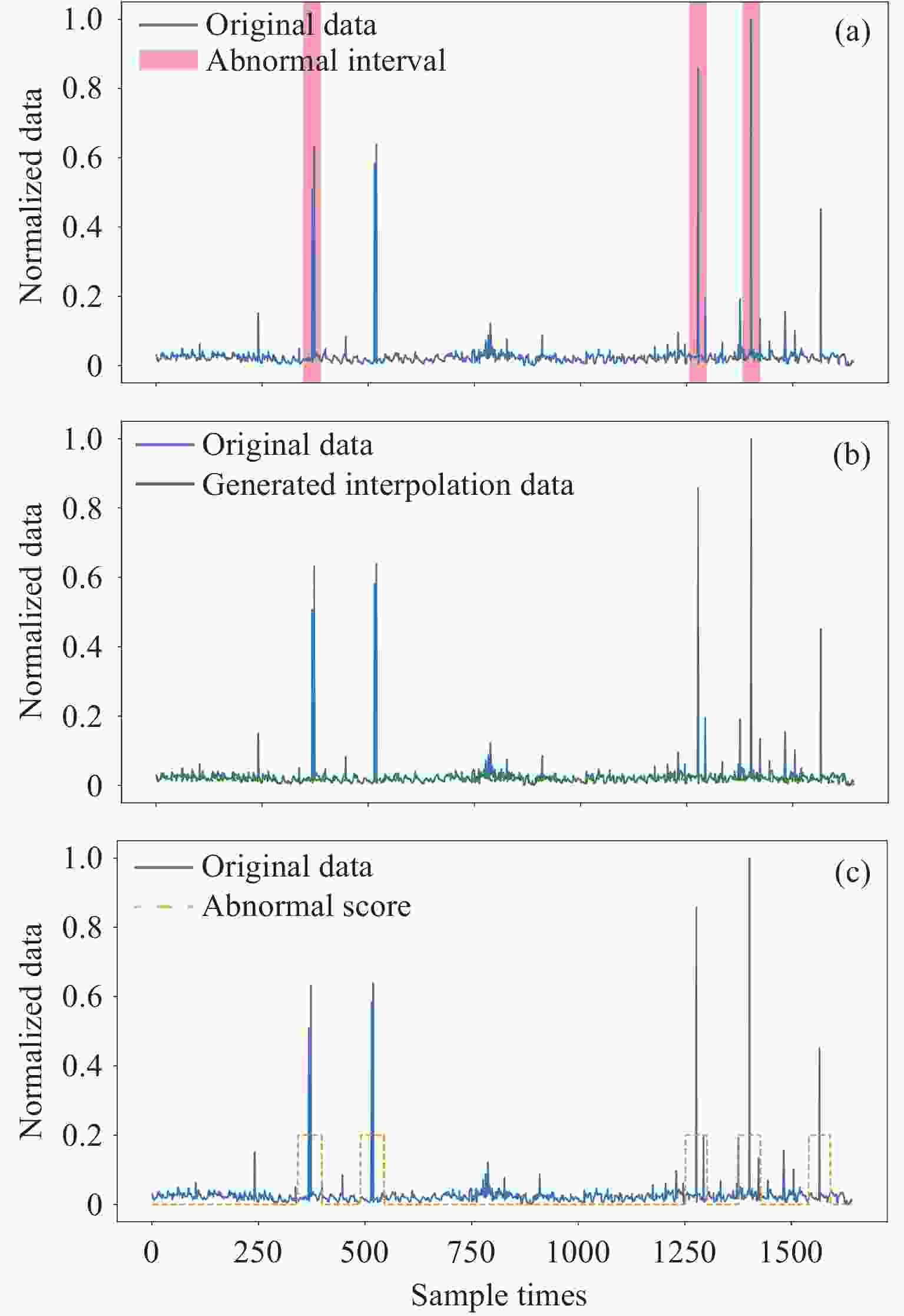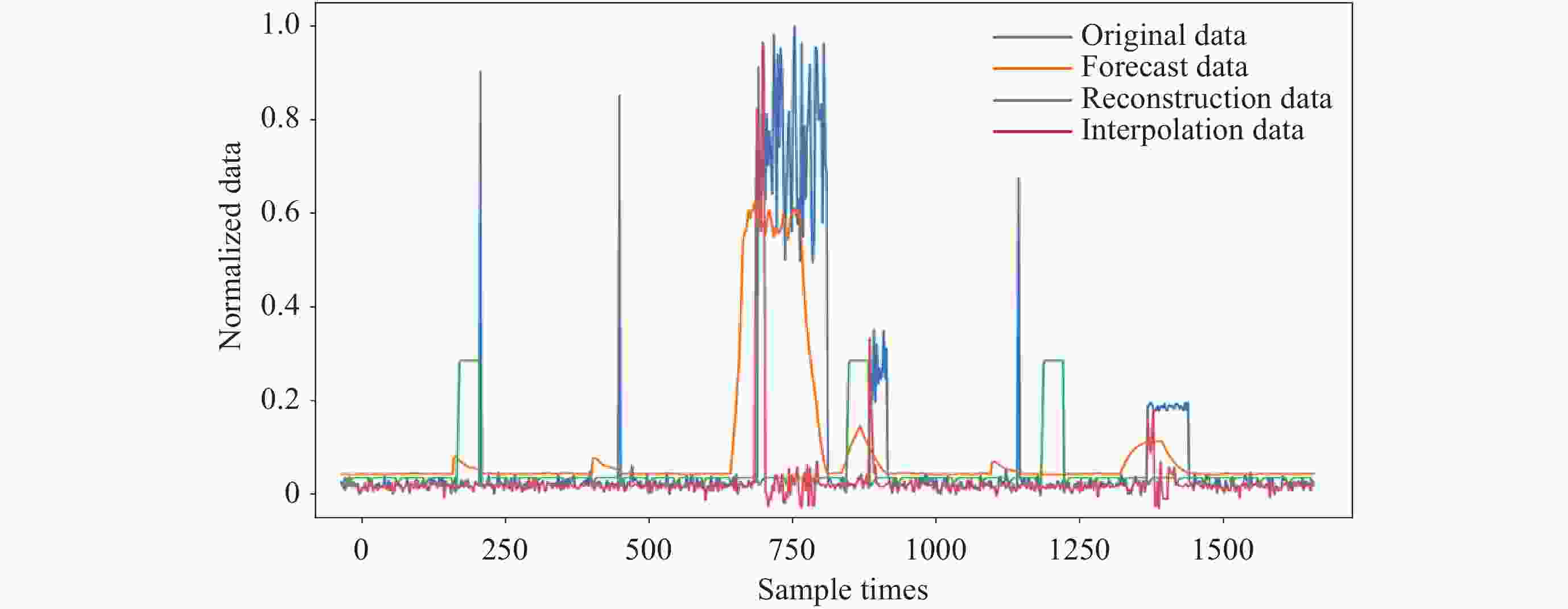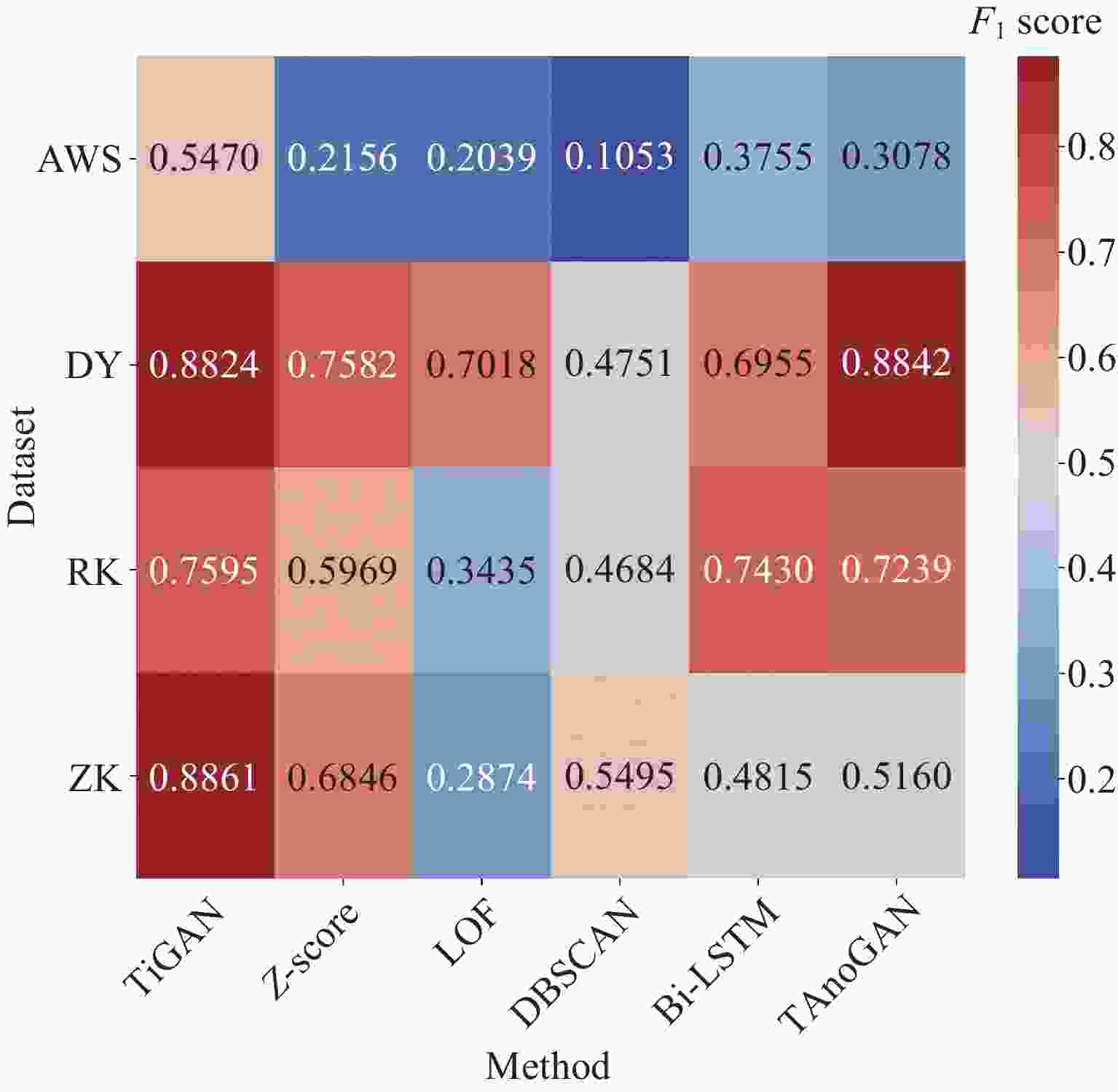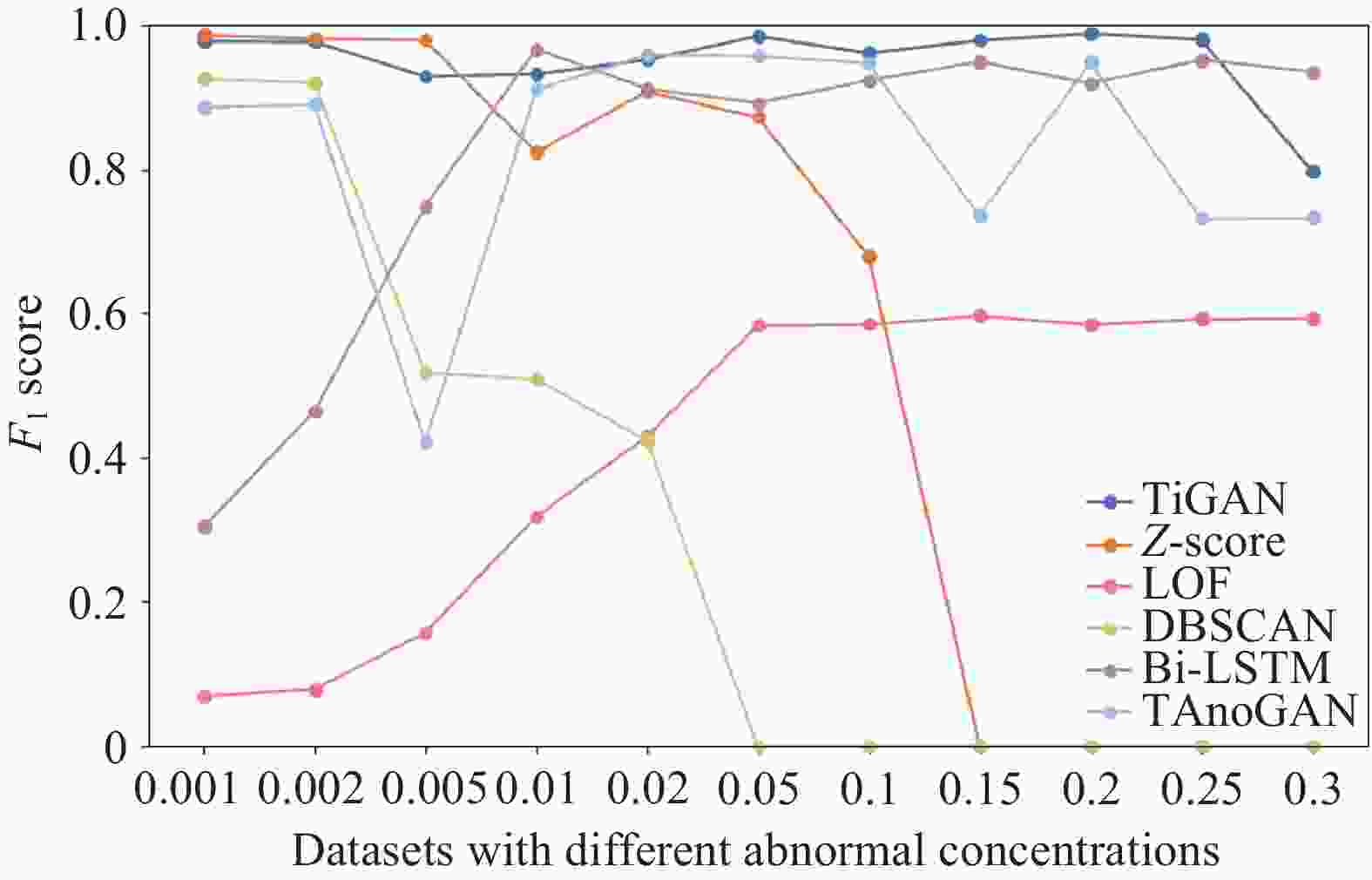Anomaly Detection Method for Satellite Telemetry Parameters Based on Time-series Imputation Generative Adversarial Networks
-
摘要: 为确保卫星的安全稳定运行, 及时进行遥测参数的数据挖掘、态势分析及异常响应至关重要. 鉴于现有方法在处理卫星遥测参数异常时存在的局限性, 提出一种基于时序插补和生成式对抗网络的异常检测方法. 该方法通过一维卷积神经网络提取时序特征, 并利用生成式对抗网络对遥测参数的分布进行建模, 创新性地采用基于插补的检测方式, 有效提高了异常检测的准确性和对复杂异常情况的适应能力. 基于真实卫星数据和公开数据集的测试结果表明, 与多种已有方法相比, 本文方法在多数数据集上获得了最高的F1分数, 并在不同的异常浓度下显示出良好的稳定性. 这一研究成果为卫星任务的地面运控进行卫星态势分析和异常处置提供了有力的决策支持.Abstract: To ensure the safe and stable operation of satellites, it is of paramount importance to promptly conduct data mining, situation analysis, and abnormal response for telemetry parameters. Given the limitations of existing methods in effectively addressing satellite telemetry parameter anomalies, this paper introduces an innovative anomaly detection method that leverages temporal interpolation and Generative Adversarial Networks (GANs). The proposed method employs a one-dimensional Convolutional Neural Network (1DCNN) to extract temporal features from the telemetry data. These features are then used to model the distribution of telemetry parameters through a generative adversarial network, which consists of a generator and a discriminator that are trained simultaneously to learn the distribution of normal data. The method innovatively incorporates a detection approach based on interpolation, which significantly enhances the accuracy of anomaly detection and the capability to handle complex and subtle anomalies that may not be easily identified by traditional methods. The effectiveness of the proposed method is validated through comprehensive testing on real satellite data as well as established public datasets. Results demonstrate that, when compared with various existing anomaly detection methods, the proposed approach achieves the highest F1 scores on the majority of the datasets tested. This indicates a superior balance between precision and recall, which is crucial for reliable anomaly detection. Furthermore, the method exhibits good stability under different anomaly densities, suggesting its robustness in varying operational conditions. This research outcome not only enhances the understanding of satellite telemetry anomalies but also provides strong decision support for ground operation in satellite mission analysis and anomaly handling, thereby contributing to the overall safety and efficiency of satellite operations.
-
表 1 实验环境配置
Table 1. Setting of the experimental environment
软硬件平台 版本参数 CPU AMD Ryzen 5700 X GPU NVIDIA Geforce RTX 4060 操作系统 Windows11 Python 3.9.18 Pytorch 2.1.1 CUDA 12.2 表 2 实验数据集数据分布情况
Table 2. Data distribution of experimental datasets
数据集 序列数 序列平均长度 2σ/(%) 3σ/(%) 异常占比/(%) AWS 17 3985 4.46 1.35 9.32 DY 5 6665 0.098 0.098 0.44 RK 7 5210 0.71 0.22 0.79 ZK 4 8129 0.18 0.16 0.43 注 2σ和3σ分别代表超过平均值2个标准差 (2σ) 和3个标准差 (3σ) 的数据点占比. 表 3 各种检测算法在数据集上的检测结果对比
Table 3. Comparison of detection results of various detection algorithms on datasets
数据集 指标 TiGAN Z-score LOF DBSCAN Bi-LSTM TAnoGAN DY F1 0.8824 0.7582 0.7018 0.4751 0.6955 0.8842 Rec 0.7895 0.6106 0.5405 0.3115 0.9997 0.9411 Pre 1.0000 1.0000 1.0000 1.0000 0.5332 0.8338 Acc 0.9871 0.9961 0.9974 0.9932 0.5362 0.9913 RK F1 0.7595 0.5969 0.3435 0.4684 0.7430 0.7239 Rec 0.7124 0.5418 0.8894 0.3788 0.9987 0.8131 Pre 0.8133 0.6643 0.2128 0.6135 0.5916 0.6253 Acc 0.9615 0.9883 0.8887 0.9805 0.6548 0.9566 ZK F1 0.8861 0.6846 0.2874 0.5495 0.4815 0.5160 Rec 0.9159 0.7199 0.6445 0.4464 0.9970 0.9837 Pre 0.8581 0.6526 0.1849 0.7143 0.3174 0.3498 Acc 0.9823 0.9917 0.8707 0.9930 0.5534 0.8918 AWS F1 0.5470 0.2156 0.2039 0.1053 0.3755 0.3078 Rec 0.8733 0.2714 0.7600 0.0563 0.8760 0.7909 Pre 0.39818 0.1788 0.1177 0.8135 0.2390 0.1911 Acc 0.6161 0.7861 0.3557 0.8960 0.3611 0.4064 注 加粗字体表示该指标下的最高值. 表 4 特征学习模块对检测结果影响的对比
Table 4. Comparison of the influence of feature learning modules on detection results
F1 分数 有特征学习模块 无特征学习模块 序列1 0.6523 0.6132 序列2 0.6531 0.2203 序列3 0.8659 0.1403 表 5 插补数量对检测结果影响的对比
Table 5. Comparison of the influence of the number of interpolations on the test results
F1 score 序列1 序列2 序列3 mask=0 0 0 0 mask=1 0.6429 0.4698 0.8552 mask=3 0.6523 0.5152 0.8552 mask=5 0.6523 0.3421 0.8670 mask=10 0.6523 0.6531 0.8659 mask=15 0.6132 0.6452 0.8670 mask=20 0.6523 0.2203 0.8479 -
[1] 王赤. 大力发展空间科学 推动我国空间活动高质量发展[J]. 中国科学基金, 2024, 38(2): 363-364WANG Chi. Developing space science vigorously to promote high-quality development of space activities in China[J]. Bulletin of National Natural Science Foundation of China, 2024, 38(2): 363-364 [2] 王赤, 邹自明, 胡晓彦, 等. 空间科学大数据与航天强国[J]. 科学通报, 2024, 69(9): 1132-1136WANG Chi, ZOU Ziming, HU Xiaoyan, et al. Big data in space science and great power of space[J]. Chinese Science Bulletin, 2024, 69(9): 1132-1136 [3] 薛玉雄, 杨生胜, 把得东, 等. 空间辐射环境诱发航天器故障或异常分析[J]. 真空与低温, 2012, 18(2): 63-70 doi: 10.3969/j.issn.1006-7086.2012.02.001XUE Yuxiong, YANG Shengsheng, BA Dedong, et al. Analyze of spacecraft system failures and anomalies attributed to the natural space radiation environment[J]. Vacuum and Cryogenics, 2012, 18(2): 63-70 doi: 10.3969/j.issn.1006-7086.2012.02.001 [4] 王亚坤, 杨凯飞, 张婕, 等. 卫星在轨故障案例与人工智能故障诊断[J]. 中国空间科学技术, 2022, 42(1): 16-29WANG Yakun, YANG Kaifei, ZHANG Jie, et al. Case study of in-orbit satellite failures and artificial intelligence based failure detection[J]. Chinese Space Science and Technology, 2022, 42(1): 16-29 [5] 王彧泽, 吕良庆, 何睿. 航天器数据定义方法及其工具设计[J]. 航天器工程, 2024, 33(1): 62-67WANG Yuze, LYU Liangqing, HE Rui. Spacecraft data definition method and tool design[J]. Spacecraft Engineering, 2024, 33(1): 62-67 [6] 杨甲森. 卫星遥测数据相关性知识发现方法研究[D]. 北京: 中国科学院大学(中国科学院国家空间科学中心), 2019YANG Jiasen. Research on correlation Knowledge Discovery Method of Satellite Telemetry Data[D]. Beijing: Chinese Academy of Sciences (National Space Science Center, the Chinese Academy of Sciences), 2019 [7] CHIKODILI N B, ABDULMALIK M D, ABISOYE O A, et al. Outlier detection in multivariate time series data using a fusion of K-medoid, standardized euclidean distance and Z-score[C]//Proceedings of the 3rd International Conference on Information and Communication Technology and Applications. Minna: Springer, 2021: 259-271 [8] TSIGKRITIS T, GROUMAS G, SCHNEIDER M. On the use of k-NN in anomaly detection[J]. Journal of Information Security, 2018, 9(1): 70-84 doi: 10.4236/jis.2018.91006 [9] SHERIDAN K, PURANIK T G, MANGORTEY E, et al. An application of DBSCAN clustering for flight anomaly detection during the approach phase[C]//Proceedings of the AIAA Scitech 2020 Forum. Orlando: AIAA, 2020: 1851 [10] 胡智超, 余翔湛, 刘立坤, 等. 基于上下文生成对抗网络的时间序列异常检测方法[J]. 哈尔滨工业大学学报, 2024, 56(5): 1-11 doi: 10.11918/202212029HU Zhichao, YU Xiangzhan, LIU Likun, et al. A time series anomaly detection method based on contextual generative adversarial network[J]. Journal of Harbin Institute of Technology, 2024, 56(5): 1-11 doi: 10.11918/202212029 [11] ZHOU T, MA Z Q, WEN Q S, et al. FEDformer: frequency enhanced decomposed transformer for long-term series forecasting[C]//Proceedings of the 39th International Conference on Machine Learning. Baltimore: PMLR, 2022: 27268-27286 [12] BASHAR A, NAYAK R. TAnoGAN: time series anomaly detection with generative adversarial networks[C]//Proceedings of 2020 IEEE Symposium Series on Computational Intelligence. Canberra: IEEE, 2020: 1778-1785 [13] LIN S Y, CLARK R, BIRKE R, et al. Anomaly detection for time series using VAE-LSTM hybrid model[C]//Proceedings of the ICASSP 2020 - 2020 IEEE International Conference on Acoustics, Speech and Signal Processing. Barcelona: IEEE, 2020. DOI: 10.1109/ICASSP40776.2020.9053558 [14] PAPARRIZOS J, KANG Y H, BONIOL P, et al. TSB-UAD: an end-to-end benchmark suite for univariate time-series anomaly detection[J]. Proceedings of the VLDB Endowment, 2022, 15(8): 1697-1711 doi: 10.14778/3529337.3529354 [15] DARBAN Z Z, WEBB G I, PAN S R, et al. Deep learning for time series anomaly detection: a survey[J]. ACM Computing Surveys, 2025, 57(1): 15 [16] GOODFELLOW I, POUGET-ABADIE J, MIRZA M, et al. Generative adversarial nets[C]//Proceedings of the 27th International Conference on Neural Information Processing Systems. Montreal: MIT Press, 2014: 2672-2680 [17] AHMAD S, LAVIN A, PURDY S, et al. Unsupervised real-time anomaly detection for streaming data[J]. Neurocomputing, 2017, 262: 134-147 doi: 10.1016/j.neucom.2017.04.070 [18] XU S Y, LIU H Y, DUAN L T, et al. An improved LOF outlier detection algorithm[C]//Proceedings of 2021 IEEE International Conference on Artificial Intelligence and Computer Applications. Dalian: IEEE, 2021: 113-117 [19] MISHRA S, KSHIRSAGAR V, DWIVEDULA R, et al. Attention-based Bi-LSTM for anomaly detection on time-series data[C]//Proceedings of the 30th International Conference on Artificial Neural Networks. Bratislava: Springer, 2021: 129-140 [20] 赵玉炜, 苏举. 基于参数自适应优化聚类的卫星状态异常检测方法[J]. 空间科学学报, 2023, 43(5): 927-937 doi: 10.11728/cjss2023.05.2022-0054ZHAO Yuwei, SU Ju. Satellite anomaly detection method based on parameter adaptive optimization clustering[J]. Chinese Journal of Space Science, 2023, 43(5): 927-937 doi: 10.11728/cjss2023.05.2022-0054 -
-





 杜晓龙 男, 2000年6月出生于河南省南阳市, 现为中国科学院国家空间科学中心在读硕士研究生, 主要研究方向为卫星智能运控技术、卫星健康管理等. E-mail:
杜晓龙 男, 2000年6月出生于河南省南阳市, 现为中国科学院国家空间科学中心在读硕士研究生, 主要研究方向为卫星智能运控技术、卫星健康管理等. E-mail:  白萌 女, 1987年6月出生, 高级工程师, 中国科学院国家空间科学中心运控部副主任, 青促会会员. 全面主持空间科学卫星在轨运行管理, 长期深耕于智能运控技术研究. E-mail:
白萌 女, 1987年6月出生, 高级工程师, 中国科学院国家空间科学中心运控部副主任, 青促会会员. 全面主持空间科学卫星在轨运行管理, 长期深耕于智能运控技术研究. E-mail: 
 下载:
下载:
